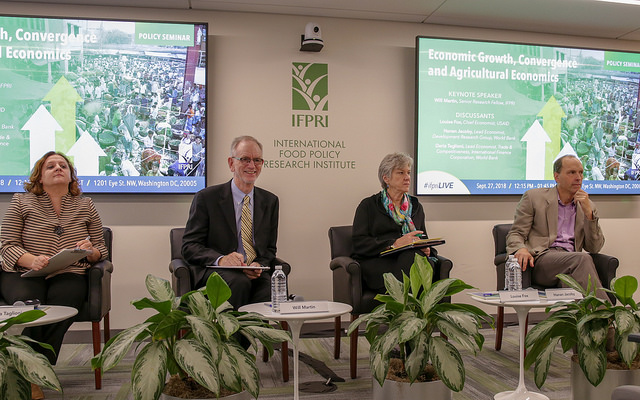Rapid growth among many developing countries over the past generation has profoundly reshaped their economies and food systems—but those countries may have to act together to respond to the global challenge of rising protectionist policies, IFPRI Senior Research Fellow Will Martin said at a policy seminar Sept. 27.
“A key group of developing countries has grown incredibly fast over the last 25 years,” Martin said at the IFPRI event, titled Economic Growth, Convergence and Agricultural Economics. “This seems normal to many of us now, but as we’ll see, this hasn’t been the norm at all. This change has major impacts on food demand, production, polices and trade.”
Martin gave a longer version of this talk as his Presidential Address at the International Conference of Agricultural Economists (ICAE) in Vancouver this July. He focused on the concept of economic convergence: Developing countries should be able to grow faster than high-income countries. But the convergence of the past 25 years is unusual, Martin noted; before it, the growth of developing countries had lagged since the beginning of the Industrial Revolution.
A combination of factors in developing countries such as China has helped to drive the recent convergence, Martin said. These include a “demographic dividend,” or economic benefits from declining fertility and mortality rates; improvements in agricultural productivity from better varieties of staple crops, which has helped to lower poverty rates and free up labor for jobs in growing industries; and global production sharing, in which the production process is spread around among many countries thanks to innovations such as containerization and improved communications.
“You no longer have to build the entire industrial structure from coal and iron at one end to a Model T Ford at the other, as was the traditional pattern in industrial development,” he said.
The economic convergence has led to convergences across developing countries’ agriculture and food systems, Martin said. Demand has shifted from basic staples to high-quality foods such as meats, dairy, fruits, and vegetables. This has had positive effects on nutrition; the rise in consumption of some animal-sourced foods is tied to falling rates of stunting, for instance. However, rising consumption of processed and high-sugar foods has helped to drive up obesity rates and associated health problems, leading to the double burden of over- and undernutrition.
Agricultural trade policies have also changed favorably in recent decades, Martin said, as protectionist measures in developed countries declined overall and developing countries expanded participation in the global economy. However, the rise in protectionist politics of the past few years threatens those gains. Developing countries should consider some form of collective action to combat this trend and encourage open trade, Martin said.
Economists continue to debate the exact role of agriculture in economic growth, said panelist Hanan Jacoby, lead economist of the World Bank Development Research Group. “Is agriculture the growth engine?” he said. “Is agriculture driving the convergence that Will has documented?” The neoclassical economic growth model, he said, posits virtually no role for agriculture as a driver of developing country growth. But the reality appears different; a recent paper attributes 80 percent of developing country economic growth from 1960-2000 to adoption of high-yield crop varieties.
Panelist Louise Fox, chief economist at the U.S. Agency for International Development, noted the rising urbanization is also driving economic change in developing countries, a trend with implications for agriculture and food systems.
“Urban governance is an issue that’s going to be key in enabling the next generation of countries to achieve strong agricultural growth, allowing them to make strong economic transformations,” Fox said. “I think urban governance is really necessary to make sure some of the linkages between rural and urban sectors happen and matter and contribute to growth.”
Daria Taglioni, lead economist for Trade and Competitiveness at the World Bank, outlined the crucial role that participation in global value chains has played in recent developing country growth.
“Global value chains allow you to import capital, technology, skills, and know-how that before was not accessible to developing countries,” she said. “So this is a big innovation. And the reason is, there is an interest in the buyer, in the lead firm, to transfer their knowledge and to actually train the supplier to do the products at a level, a quality that is a global standard.”
Martin and the panelists examined some of the reasons why some regions—particularly Africa south of the Sahara and parts of Latin America—have lagged behind fast-growing countries of Asia and elsewhere.
Fox said that she believed Africa would not realize a demographic dividend. “Africa is changing so slowly, that most countries will not see a dividend like China did, or East Asia—Thailand—that changed very rapidly,” she said.
Taglioni noted that Africa and parts of Latin America, have not fully engaged with global value chains. But there are some signs of change with the recently-formed African Continental Free Trade Area, she said. “It contains a lot of the elements that underline the thinking around GVCs, and it really primes the idea of integrating markets for making possible this type of production, trade and growth.”







